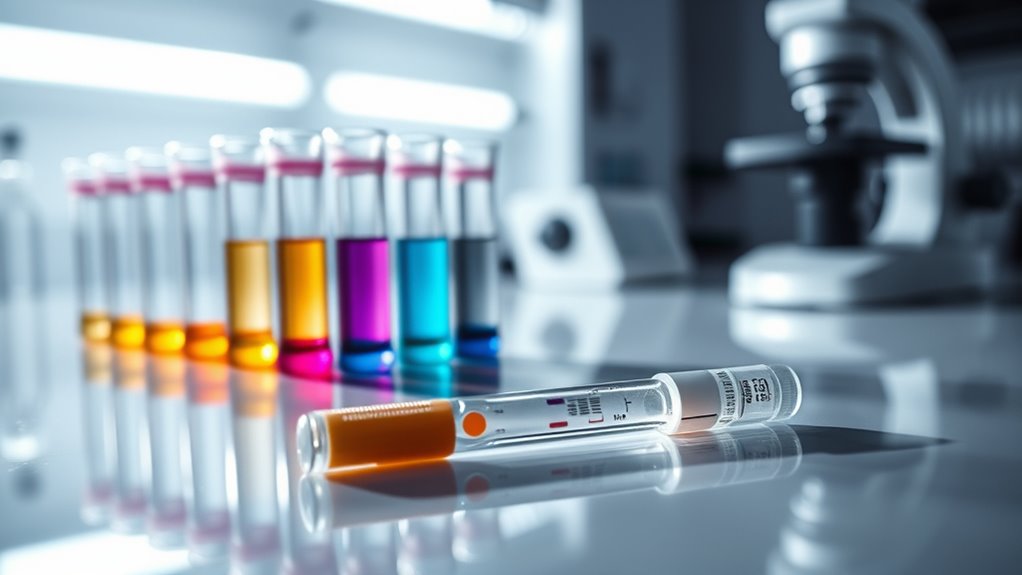False negative tests happen when a diagnostic test wrongly shows a condition is absent. This can occur due to incorrect test administration, timing factors, or issues during sample collection. If a test lacks high sensitivity, it’s even more likely to miss actual positives. These errors can delay treatment and worsen health issues, posing risks for you and others. There’s a lot more to understand about these tests and their implications, so let’s explore further.
Key Takeaways
- Incorrect test administration can lead to inaccurate results, resulting in false negatives.
- Timing of the test is crucial; testing too early or late can affect accuracy.
- Variability in viral shedding may cause infectious individuals to test negative.
- Sample collection issues can result in insufficient information for accurate diagnosis.
- Tests with lower sensitivity are more likely to produce false negatives.

When you receive a test result indicating a condition isn’t present, it’s crucial to understand the implications of a false negative. A false negative occurs when a test incorrectly shows that a condition is absent, even when it’s actually there. This can have serious consequences, especially for conditions like diabetes or COVID-19, where delayed treatment can worsen the situation. If you get a negative result but still feel unwell, it’s essential to seek further evaluation.
Understanding false negatives is vital; they can lead to untreated conditions and worsen health outcomes. Seek further evaluation if symptoms persist.
Several factors contribute to false negatives in medical testing. For instance, incorrect test administration can lead to inaccurate results. If the test isn’t performed properly, it may fail to detect an existing condition. Additionally, the timing of the test plays a critical role. Testing too early or late in the infection cycle can impact the accuracy, as viral shedding can vary significantly. For COVID-19, this variability means that a person could be infectious without a positive test result. The false negative rate (FNR) is a critical measure to consider when evaluating the effectiveness of diagnostic tests.
Sample collection issues can also lead to false negatives. If a sample isn’t collected correctly, it may not provide the necessary information for an accurate diagnosis. The sensitivity of the test itself is another determining factor; tests with lower sensitivity are more prone to false negatives. This is especially true for rapid antigen tests used for COVID-19, which have been shown to yield many false negatives.
From a statistical perspective, false negatives represent a type II error, meaning that an actual positive goes undetected. The false negative rate (FNR) tells us how often this happens, impacting the overall power of the test. Reducing false negatives often leads to an increase in false positives, creating a trade-off between these two errors.
In public health, the implications of false negatives are significant. They can delay necessary medical interventions, potentially allowing diseases to spread unnoticed. This not only places individuals at risk but can also burden healthcare systems with unnecessary tests and associated costs. Moreover, the psychological impact of receiving a false negative can cause anxiety and stress for both patients and their families.
In legal contexts, false negatives can lead to grave consequences, such as the acquittal of guilty individuals. The ethical considerations surrounding this issue highlight the tension between ensuring justice and maintaining fairness.
Frequently Asked Questions
How Can I Reduce the Risk of False Negative Tests?
To reduce the risk of false negative tests, you should create detailed test plans that cover various scenarios, including edge cases.
Regularly update these plans to reflect changes in the application.
Utilize reliable automation frameworks and ensure your testing environments mimic production settings.
Additionally, implement adaptive screening and repeat tests to increase detection chances.
Are There Specific Tests More Prone to False Negatives?
Imagine holding a test that’s supposed to reveal a hidden truth about your health.
Some tests, like rapid antigen tests and certain immunoassays, are more prone to false negatives. If you’re not swabbing deeply enough or using an inadequate sample, the results might mislead you.
Additionally, the timing of your test plays a crucial role; if you test too early, you might miss the virus entirely.
Always consider the context and consult a healthcare professional if unsure.
What Should I Do if I Suspect a False Negative?
If you suspect a false negative, it’s important to take action.
Start by retesting after a few days for clarity. Consult a healthcare professional to discuss your concerns and get further evaluation.
You might consider alternative tests that offer higher sensitivity.
Also, reflect on your exposure history and risk factors, as they can influence your test’s accuracy.
Taking these steps can help ensure you receive the right diagnosis and appropriate care.
Can Lifestyle Factors Influence Test Accuracy?
Did you know that nearly 70% of blood test results can be influenced by lifestyle factors?
Yes, your diet, exercise, sleep, and habits like smoking or drinking can all impact test accuracy. For instance, regular exercise can improve your lipid profiles, while a balanced diet reduces inflammation.
These changes can lead to more reliable test results, helping you and your healthcare provider make better decisions about your health.
How Do False Negatives Affect Public Health Measures?
False negatives can seriously undermine public health measures.
When you receive a negative test result, you might feel a false sense of security, leading you to relax precautions like masking and social distancing. This behavior increases the risk of spreading the virus, especially among asymptomatic individuals.
It’s crucial to remember that negative tests aren’t foolproof, and maintaining vigilance is essential to protect yourself and others in your community.
Conclusion
In the realm of testing, false negatives are like shadows lurking in the corners of certainty, ready to distort the truth. They can lead to missed diagnoses and delayed treatments, leaving you in the dark when clarity is crucial. Understanding why these errors happen empowers you to navigate your health decisions more confidently. By staying informed and vigilant, you can shine a light on potential issues, ensuring you don’t overlook what truly matters.









